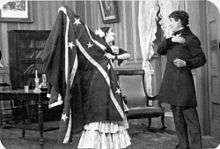The House with Closed Shutters
The House with Closed Shutters is a 1910 American silent drama film directed by D.W. Griffith and released by the Biograph Company.[1]
| The House with Closed Shutters | |
|---|---|
 | |
| Directed by | D. W. Griffith |
| Written by | Emmett C. Hall |
| Starring | Henry B. Walthall |
| Cinematography | G. W. Bitzer |
| Distributed by | Biograph Company |
Release date |
|
Running time | 16 minutes |
| Country | United States |
| Language | Silent (English intertitles) |
Plot
During the American Civil War a young soldier loses his nerve in battle and runs away to his home to hide; his sister puts on his uniform, takes her brother's place in the battle, and is killed. Their mother, not wanting the shameful truth to become known, closes all the shutters (hence the film's title) and keeps her son's presence a secret for many years, until two boyhood chums stumble upon the truth.
Cast
- Henry B. Walthall as The Confederate soldier
- Grace Henderson as His mother
- Dorothy West as His sister
- Joseph Graybill as Her suitor
- Charles West as Her suitor
- William J. Butler as The colored servant (credited as W. J. Butler)
- Edwin August
- Verner Clarges as In Lee's Tent
- John T. Dillon as On Porch / At Farewell / In Lee's Tent (credited as Jack Dillon)
- Gladys Egan as On Porch / At Farewell
- Frank Evans as In Lee's Tent
- Francis J. Grandon as In Lee's Tent
- Alfred Paget as On Porch / At Farewell
- Mabel Van Buren as On Porch / At Farewell
Production
The House with Closed Shutters was filmed between June 25 and July 2, 1910, at the Biograph studios and on location in Fort Lee, New Jersey.[1]
Commentary
Unlike the portrayal of women in film serials where they tend to be in peril and need to be saved, West's "sister" character, while dressed in her brother's uniform, was in control of her situation as she rode over the same dangerous route that her brother had taken in his flight.[2] Her horsemanship is emphasized over the other male riders, as soon as she is on the horse she rides at full speed and she alone among the riders has her horse rear up on its hind legs.[3]
Preservation
Prints of The House with Closed Shutters exist in the film archives of the Museum of Modern Art, George Eastman House, and the Library of Congress.[1]
References
- "Progressive Silent Film List: The House with Closed Shutters". silentera.com. Retrieved March 25, 2008.
- Horak, Laura (Summer 2013). "Landscape, Vitality, and Desire: Cross-Dressed Frontier Girls in Transitional-Era American Cinema". Cinema Journal. University of Texas Press. 52 (4): 84–85. doi:10.1353/cj2013.0041. ISSN 0009-7101. JSTOR 00097101. Retrieved March 25, 2020.
- Horak, p. 86-87.
External links
- The House with Closed Shutters on IMDb
- The House with Closed Shutters is available for free download at the Internet Archive